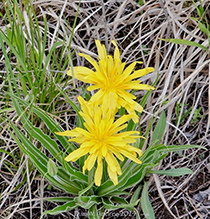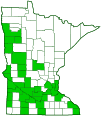prairie false dandelion
(Nothocalais cuspidata)
Conservation • Description • Habitat • Ecology • Use • Distribution • Taxonomy
|
|
||||||||||||||
Description |
Prairie false dandelion is a showy, easily identified, prairie wildflower. It occurs in the United States from Wisconsin to Illinois, west to Idaho and New Mexico, and in southern Saskatchewan and Alberta Canada. It is found in upland prairies, hill prairies, pastures, and rocky slopes. It grows under full sun, in dry conditions, in well drained, rocky, sandy, or otherwise gritty soil. It is not tolerant of disturbance. Prairie false dandelion is a 2¾″ to 13¾″ (7 to 35 cm) tall, perennial forb that rises on a rosette of basal leaves and usually a single flowering stem from a taproot and clusters of lateral rootlets. The taproot is large, thick, fleshy, and somewhat woody and hardened. It has a blackish, tough, bark-like, outer protective layer (periderm). The stems and leaves emit a milky latex when cut or torn. The rosette of basal leaves is up to 10″ (25 cm) in diameter. The leaves are 2¾″ to 11¾″ (7 to 30 cm) long, and ⅛″ to ¾″ (3 to 20 mm) wide. They are usually stalkless and somewhat sheathing at the base, but sometimes they are attached by an indistinct, short, winged stalk. There are usually 2 or 3 short, ⅜″ to 1 9⁄16″ (1 to 4 cm) long, brown, scale-like leaves at the outside of the rosette. Each leaf blade is grass-like (linear) or linear lance-shaped. The leaf tip is tapered with concave sides (acuminate). There is a prominent, single, pale, broad midrib, and a faint network of secondary veins. The secondary veins are long, and they join together before reaching the margin (anastomosing). The margins are unlobed. They may be flat or wavy, and they are densely covered with short, curled hairs (ciliate). On the upper side, there are often long curled hairs along the midrib. The upper and lower surfaces may be otherwise hairless, or they may have a sparse covering of long curled hairs, becoming denser near the tip. There is usually just a single flowering stem. The stem is erect, unbranched, 2¾″ to 13¾″ (7 to 35 cm) tall, and finely lined or ridged. It is leafless, and it is moderately to densely covered with white, curled to woolly hairs, especially on the upper two-thirds. The inflorescence is a single, 1″ to 2″ (25 to 51 mm) wide flower head at the end of each stem. The whorl of modified leaves (bracts) at the base of the flower head (involucre) is bell shaped, ½″ to 1 1⁄16″ (13 to 27 mm) long, and 3 ⁄16″ to ¾″ (5 to 20 mm) wide at flowering time. It is composed of 13 to 34 lance-shaped to narrowly lance-shaped bracts (phyllaries) arranged usually in 2 overlapping series. The phyllary margins are thin and pale, and there is sometimes a faint purple midvein or purplish spots. The flower head has 35 to 80 bright yellow florets. Each floret is tube-like at the base and strap-shaped from the tube to the end. The strap-shaped portion (ligule) is ⅝″ to 1 1⁄16″ (15 to 27 mm) long, and the tip is fringed. The fruit is a dry, one-seeded seed capsule (cypsela). The cypsela is yellowish brown to brown, ¼″ to ⅜″ (7 to 10 mm) long, narrowly cylinder-shaped, and slightly tapered at the base. It is not flattened, it is not expanded at the tip, and it does not have a narrow extension (beak) at the tip. The surface has usually 10 ribs, and there is a tuft (pappus) of 40 to 80 bristles (pappi) at the tip. The pappi are white, 5⁄16″ to 7⁄16″ (8 to 11 mm) long, and minutely barbed. |
Height |
2¾″ to 13¾″ (7 to 35 cm) |
Flower Color |
Yellow |
Similar Species |
Pale agoseris (Agoseris glauca var. glauca) is a taller plant, up to 18″ (46 cm) in height. The flowering season is May to September. It is found in wet or moist areas. |
Habitat |
Dry. Full sun. Well drained, rocky, sandy, or otherwise gritty soil. |
Ecology |
Flowering |
April and May |
Pests and Diseases |
|
Use |
|
Distribution |
||
|
Sources |
|
| 5/31/2024 | ||
Nativity |
||
Native |
||
Occurrence |
||
|
||
Taxonomy |
|
Kingdom |
|
Division |
Tracheophyta (Vascular Plants) |
Subdivision |
Spermatophytina (Seed Plants) |
Class |
|
Order |
Asterales (Sunflowers, Bellflowers, Fanflowers, and Allies) |
Family |
Asteraceae (Sunflowers, Daisies, Asters, and Allies) |
Subfamily |
Cichorioideae (chicories, dandelions, and allies) |
Tribe |
Cichorieae (lettuce, chicory, dandelion, and salsify) |
Subtribe |
Microseridinae |
Genus |
Nothocalais (false dandelion) |
This species was formerly classified as Microseris cuspidata. A morphological analysis (Chambers, 1957) argued for separating four Microseris species into a new genus Nothocalais based on a unique combination of character states. Later molecular studies (Jansen et al., 1991 and Whitton et al, 1995) supported the separation. Plants of the World Online continues to classify this species as Microseris cuspidata. They appear to be unique in that respect. |
|
Subordinate Taxa |
|
|
|
Synonyms |
|
Agoseris cuspidata Microseris cuspidata |
|
Common Names |
|
microseris prairie dandelion prairie false dandelion sharppoint microseris sharppoint prairie-dandelion wavy-leaf prairie-dandelion wavy-leaved prairie dandelion |
|
Glossary
Acuminate
Gradually tapering with concave sides to a sharply pointed tip.
Anastomosing
Referring to veins, such as on a plant leaf or a lichen, or lines on an insect wing, that branch and rejoin, forming a network.
Beak
In plants: A comparatively short and stout, narrow or prolonged tip on a thickened organ, as on some fruits and seeds. In insects: The protruding, tubular mouthpart of a sucking insect.
Cypsela
A dry, one-chambered, single-seeded seed capsule, formed from a single carpel, with the seed attached to the membranous outer layer (wall) only by the seed stalk; the wall, formed from the wall of the inferior ovary and also from other tissues derived from the receptacle or hypanthium, does not split open at maturity, but relies on decay or predation to release the contents.
Involucre
A whorl of bracts beneath or surrounding a flower, flower head, or flower cluster.
Ligule
In grasses and sedges, an outgrowth on the leaf at the junction of the blade and the sheath, usually membranous, sometimes no more than a fringe of hairs. In flowering plants, the ligule is the flat, strap-shaped, petal-like portion of the corolla of a ray floret.
Linear
Long, straight, and narrow, with more or less parallel sides, like a blade of grass.
Pappus
The modified calyx composed of awns, scales, bristles, or feather-like hairs in plants of the Asteraceae family.
Phyllary
An individual bract within the involucre of a plant in the Asteraceae family.
Rosette
A radiating group or cluster of leaves usually on or close to the ground.
Sheath
The lower part of the leaf that surrounds the stem.
Winged leaf stalk
A leaf stalk with a leaf-like or membrane-like extension along both sides.
Visitor Photos |
||
Share your photo of this plant. |
||
This button not working for you? |
||
Dan W. Andree |
||
 |
|
|
MinnesotaSeasons.com Photos |
||
|
||
|
||

Slideshows |
Nothocalais cuspidata |
 |

Visitor Videos |
||
Share your video of this plant. |
||
This button not working for you? |
||
|
Other Videos |
||
Agoseris-cuspidata-Prairie-Dandelion |
About
13 years ago http://www.prairiemoon.com - Prairie Dandelion is very different from the Dandelion we are all familiar with. Learn more by watching this short video from Prairie Moon Nursery. |

|
Created: 5/31/2024 Last Updated: © MinnesotaSeasons.com. All rights reserved. |



